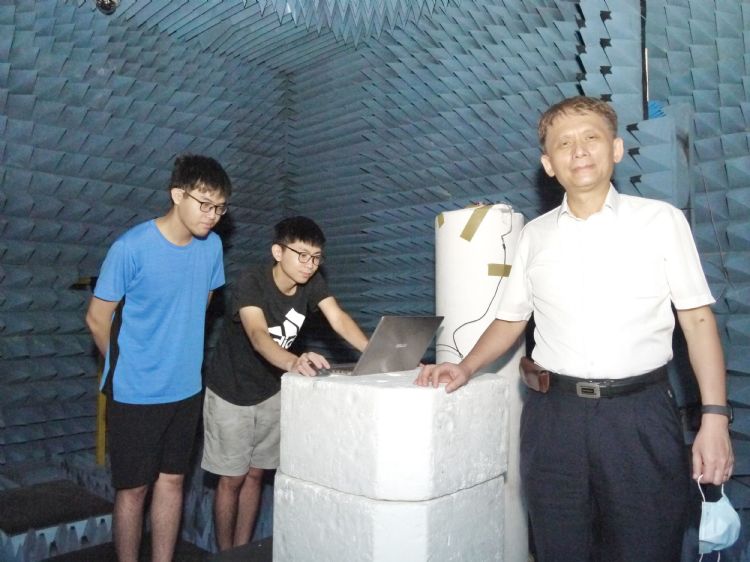Taiwan Tech to develop near-field OTA validations for 5G active antennas together with mmWave antenna and connector designs

Chang-Fa Yang (right), the director of the wireless center at Taiwan Tech.
Photo: DIGITIMES
With the standards for the 5G protocols largely established, wireless communication providers in the US and Korea started to offer the service in select major cities starting third-quarter 2019. Not to fall behind, Taiwan also completed the bidding for its 5G bandwidths towards the end of 2019 and started offering services during second-quarter 2020, marking Taiwan among one of the fewer countries in the world currently capable of sustaining 5G communications. 5G communication has the advantage of higher data throughput, wider bandwidths, lower latencies, and can support much higher volume of connections. However, 5G networks require more base stations in a given area to provide users good coverages and services. Consequently, this has led to a rush from telecommunication companies investing in the deployments of the base stations to expedite the availability of the 5G networks.
The deployment process of the 5G base stations may be significantly hindered if antenna specifications are not clear from the outset. To solve this problem, the Chunghwa Telecom Laboratories and NTUST (Taiwan Tech) Wireless Communication and Electromagnetic Compatibility Research Center are working together to develop near-field OTA validation technologies applicable on performance characterization and optimization with 5G digital active antenna configurations.
Chang-Fa Yang, the director of the wireless center, says that current 5G active antenna validations usually adopt a far-field approach that is only able to validate antenna radiation patterns but is not able to accurately assess the currents on antenna surfaces to analyze individual antenna elements for optimization. With the development of the near-field validation technology for 5G active antennas, one can better keep track of the real-world performance of each antenna so that deployment results can better match initial planning. Also, validation services will be available soon to companies developing 5G active antennas, aiding with entry into the 5G equipment market and optimization of the 5G base station deployments.
mmWave antenna and connector designs
Founded in 2003, Taiwan Tech Wireless Communication and Electromagnetic Compatibility Research Center has been conducting research in areas like antenna design, microwave/mmWave circuits, RFID, internet of things, high-speed and high-frequency connectors, RF integrated circuits, electromagnetic compatibility, wave propagation, etc. This center has exceptional results in various industry-academia collaboration projects and has successfully delivered mmWave antennas as well as high-speed and high-frequency connector products that meet the needs of the industry.
A joint-industry research center to help enterprises break through economic threshold
Taiwan's economy is dominated by small and medium-sized enterprises. In the face of such a highly competitive international market, even if the industry wanted to strengthen its research capability, it would be difficult for them to compete with international companies. This is why many enterprises are choosing to enter into industry-academia collaboration projects with universities. Naturally, NTUST Wireless Communication and Electromagnetic Compatibility Research Center has become the collaboration partner of choice for many enterprises thanks to the center's comprehensive suite of microwave and mmWave measurement systems. Nextronics Engineering, for example, was able to develop a variety of innovative products and successfully enhance its competitiveness in the international market by working closely with the center for a decade now.
The Wireless Communication and Electromagnetic Compatibility Research Center is extensively equipped with anechoic chambers, including a spherical near-field, a cylindrical and planar near-field, a far-field, a millimeter wave antenna measurements, and a passive intermodulation (PIM) chamber together with related instruments and equipment. Those facilities are used by faculty and students to conduct research and development of the related technologies and products to establish long-term and tightly-knit industry-academia relationships. It is hoped that this relationship will serve as the foundation for the R&D upgrade of the wireless communication industry in Taiwan and help with establishing key technologies and cultivating high-level R&D talents that are in great demand by the industry.
The Taiwan Tech's Global Research & Industry Alliance (GLORIA) team is looking forward to working with more domestic and foreign enterprises in the future to leverage the center's R&D energy to nurture more talents in related fields and contribute to the long-term development of Taiwan's industries.
Article Extraction from DIGITIMES
https://www.digitimes.com/news/a20210927VL200.html
